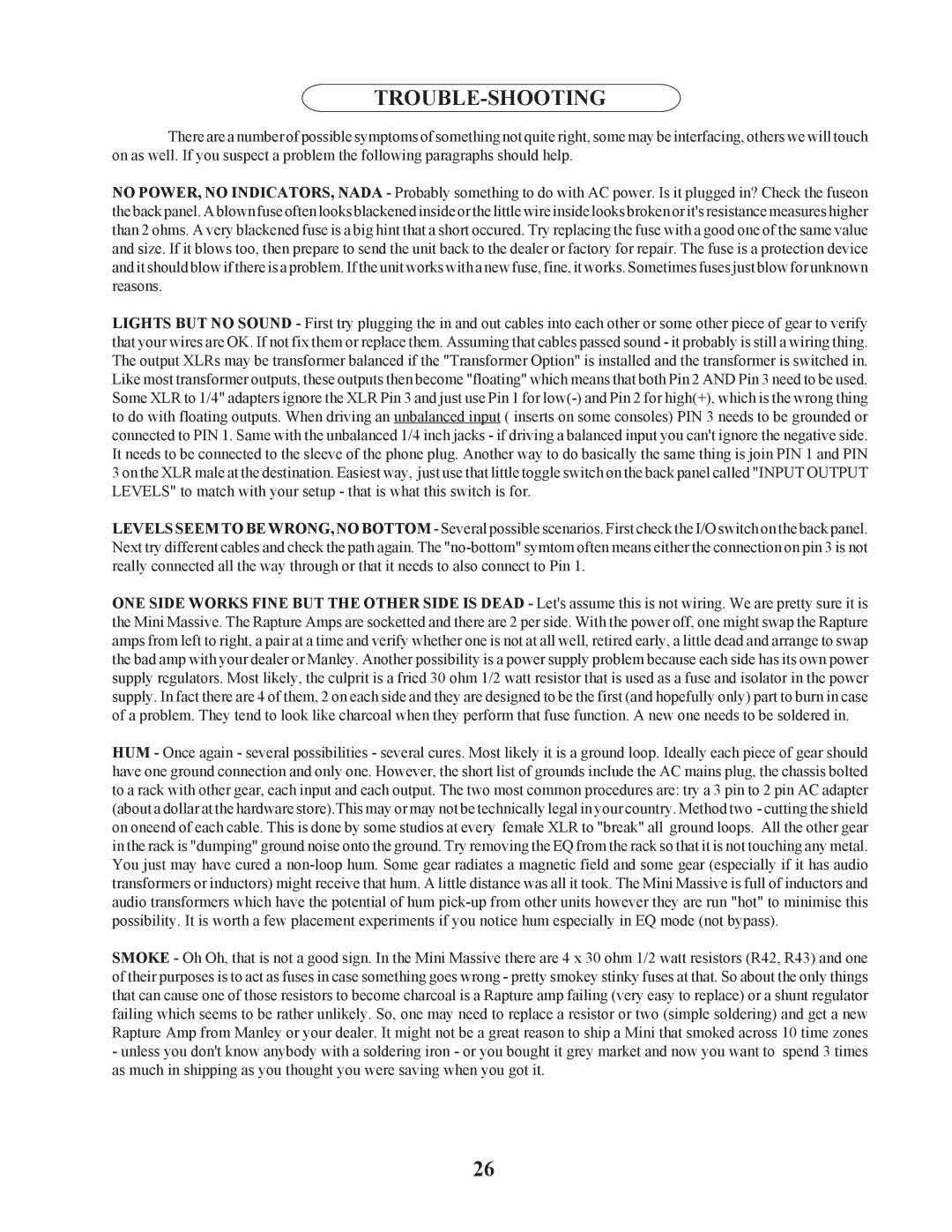TROUBLE-SHOOTING
There are a number of possible symptoms of something not quite right, some may be interfacing, others we will touch on as well. If you suspect a problem the following paragraphs should help.
NO POWER, NO INDICATORS, NADA - Probably something to do with AC power. Is it plugged in? Check the fuseon the back panel. A blown fuse often looks blackened inside or the little wire inside looks broken or it's resistance measures higher than 2 ohms. A very blackened fuse is a big hint that a short occured. Try replacing the fuse with a good one of the same value and size. If it blows too, then prepare to send the unit back to the dealer or factory for repair. The fuse is a protection device and it should blow if there is a problem. If the unit works with a new fuse, fine, it works. Sometimes fuses just blow for unknown reasons.
LIGHTS BUT NO SOUND - First try plugging the in and out cables into each other or some other piece of gear to verify that your wires are OK. If not fix them or replace them. Assuming that cables passed sound - it probably is still a wiring thing. The output XLRs may be transformer balanced if the "Transformer Option" is installed and the transformer is switched in. Like most transformer outputs, these outputs then become "floating" which means that both Pin 2 AND Pin 3 need to be used. Some XLR to 1/4" adapters ignore the XLR Pin 3 and just use Pin 1 for
LEVELS SEEM TO BE WRONG, NO BOTTOM - Several possible scenarios. First check the I/O switch on the back panel. Next try different cables and check the path again. The
ONE SIDE WORKS FINE BUT THE OTHER SIDE IS DEAD - Let's assume this is not wiring. We are pretty sure it is the Mini Massive. The Rapture Amps are socketted and there are 2 per side. With the power off, one might swap the Rapture amps from left to right, a pair at a time and verify whether one is not at all well, retired early, a little dead and arrange to swap the bad amp with your dealer or Manley. Another possibility is a power supply problem because each side has its own power supply regulators. Most likely, the culprit is a fried 30 ohm 1/2 watt resistor that is used as a fuse and isolator in the power supply. In fact there are 4 of them, 2 on each side and they are designed to be the first (and hopefully only) part to burn in case of a problem. They tend to look like charcoal when they perform that fuse function. A new one needs to be soldered in.
HUM - Once again - several possibilities - several cures. Most likely it is a ground loop. Ideally each piece of gear should have one ground connection and only one. However, the short list of grounds include the AC mains plug, the chassis bolted to a rack with other gear, each input and each output. The two most common procedures are: try a 3 pin to 2 pin AC adapter (about a dollar at the hardware store).This may or may not be technically legal in your country. Method two - cutting the shield on oneend of each cable. This is done by some studios at every female XLR to "break" all ground loops. All the other gear in the rack is "dumping" ground noise onto the ground. Try removing the EQ from the rack so that it is not touching any metal. You just may have cured a
SMOKE - Oh Oh, that is not a good sign. In the Mini Massive there are 4 x 30 ohm 1/2 watt resistors (R42, R43) and one of their purposes is to act as fuses in case something goes wrong - pretty smokey stinky fuses at that. So about the only things that can cause one of those resistors to become charcoal is a Rapture amp failing (very easy to replace) or a shunt regulator failing which seems to be rather unlikely. So, one may need to replace a resistor or two (simple soldering) and get a new Rapture Amp from Manley or your dealer. It might not be a great reason to ship a Mini that smoked across 10 time zones
-unless you don't know anybody with a soldering iron - or you bought it grey market and now you want to spend 3 times as much in shipping as you thought you were saving when you got it.
26
